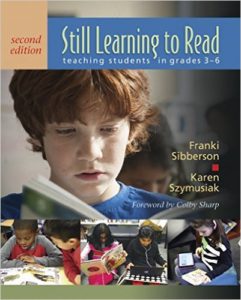Still Learning to Read in the Early Middle Grades
Still Learning to Read: Teaching Students in Grade 3-6 (2nd Edition)
By Franki Sibberson and Karen Szymusiak
(Stenhouse Publishers, 2016 – Learn more)

Has it really been 13 years since the first publication of Still Learning to Read? In that time, much has changed in education – so much that the authors believed they needed to write a second edition to address some of those changes. Don’t worry, though. All the goodness is still there!

The book is divided into two parts; Part 1, “Making the Most of Time and Space,” has four chapters, and Part 2, “Threads of Learning Throughout the Year,” has five.
“Learning to read” beyond 3rd grade
In Chapter 1, “Teaching Reading in the Upper Elementary Classroom,” the authors start out with an explanation of what reading instruction looks like in grades 3-6.
Many of us have heard the myth, “Learn to Read (then) Read to Learn.” However, the authors point out that this myth (which has influenced reading instruction in many classrooms for years) is not working. State standards, testing and other mandates, and some state’s retention laws, have changed the educational landscape.
We need to remember that our older students are still building their reading identities and still have much to learn about how to read effectively and enthusiastically. The authors offer practical suggestions and reading recommendations that can advance this very important developmental work.
Establishing a literate classroom to meet student needs
In Chapter 2, “Making the Most of Time and Space,” the authors recommend books to include in a classroom library. They also offer suggestions for how to organize the classroom library, making items easily accessible for both teachers and students.
Chapter 3, “Preparing for Thoughtful Instruction Before Our Students Enter the Classroom,” includes advice on how to organize the classroom library and student work spaces, how to best schedule your time to make the most of your Reading and Writing Workshops, and how to build routines once the students arrive.
Chapter 4 goes more in depth about the instructional components necessary for a successful, literate classroom. The authors set out their beliefs about what students deserve, and then give practical suggestions for implementing these practices in your own classroom.
One of my favorite chapters is Chapter 5, “Grouping Beyond Levels.” The authors stress the importance of getting to know our readers beyond just their reading level. We see two seemingly similar readers, if we only look at their reading level, but Sibberson and Szymusiak describe how our teaching would need to be different with each reader in order to help them progress. They also examine book selecting, student grouping, and choosing a focus of instruction. There are sample lessons and planning tools included to help teachers accomplish all of these tasks.
What works and resources to support it
In Part 2, “Threads of Learning Throughout the Year,” the authors address read-alouds, book choice and book sharing, how to scaffold our readers in both fiction and non-fiction, and the role of close reading in grades 3-6. As with Part 1, there are several sample lessons and book recommendations included.
Throughout the book, readers will find QR codes linking to videos of interviews with the authors as well as one of Sibberson working with her class. Stenhouse also has a study guide that accompanies the book, which is great if you and your colleagues are reading this book together.
In the Epilogue, the authors close by stating:
We stand strong on our beliefs. We plan authentic experiences so our students can understand what it is to be lifelong readers. We celebrate a joyful reading life with them.”
Sibberson and Szymusiak encourage us to join them in their journey as we are all “still learning to read.” I would certainly encourage you to continue your learning journey by reading this book!
Pam Hamilton is an intermediate literacy coach in Middlebury, Indiana. In her 23 years of teaching, she has also taught first and second grades, Reading Recovery and Title I Intervention groups. She lives in Northeast Indiana and enjoys being a lifelong learner.

































